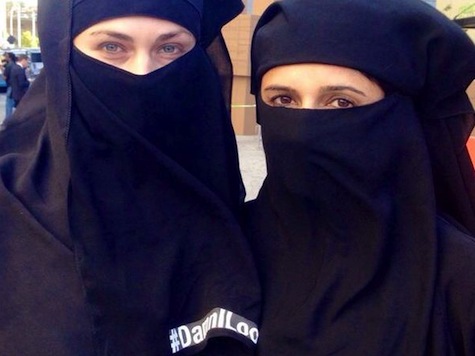Two Upper West side artists think New York women should try wearing face masks, also known as “niqab.”Their names are Saks Afridi and Quinza Najm. They are calling upon women to don black face masks and take a “selfie.”
The political art project began as a private experiment when Najm began wearing niqab (erroneously referred to as “hijab,” which is just a headscarf) in her neighborhood; she encountered some hostile responses. “Go home!”
At that point, Najm decided that concealing her facial identity was an act of assertive liberation and a challenge to a presumably “tolerant” America. She launched a hashtag #DamniLookGood and asked other women, both Muslim and non-Muslim–men too–to don niqab as “an exercise in tolerance.”
Some women who tried on the black niqab and close black head covering found it “sexy” to be concealed. Najm also points out that you can wear “crappy clothes” underneath and be very “comfortable.” (Here she must be talking about a full body covering as well).
The two artists claim, on their website, that a woman can “choose” to wear niqab and when she does she is “in complete control of her sexuality, and ultimately that’s what makes her so beautiful.”
Western adventurers and artists have a long history of “slumming.” They go “native,” both politically and in terms of couture. Lawrence of Arabia and Isabelle Eberhardt both dressed the part of Arabs. European and American leftists marching against America and for “Palestine” often don keffiyas which they wear around their necks but which can also be worn as face and head masks.
I wonder what Afridi and Najm would have to say to all those girls and women who have been honor murdered for refusing to face-veil, to wear hijab (headscarves) or because their wore their veils improperly; or to those fifteen Saudi teenage girls who tried to flee the fire burning down their schoolhouse but were pushed back in to their deaths because the Morality Police did not want them to survive if they were, even temporarily, naked-faced.
These artists and all who agree with them are treating what is mainly a forced choice in the Muslim world (and in Muslim communities in the West), as a potentially free choice. They are, in essence, donning the equivalent of “black face,” or slave chains, and saying that this feels good–in New York City, where they are only play-acting, and can remove their face veils without any negative consequence.
Some tribal, ethnic, and religious customs violate American law (e.g. polygamy, female genital mutilation, forced child marriage, purdah– honor based violence, including honor killing–and face veiling). Although I do not want the government telling women what to wear and what not to wear, I have nevertheless concluded that the face veil (“niqab”) is both a security and health risk as well as a violation of women’s human rights to participate in public society.
In our times, the Islamic face and body veil signify the utter subordination of women. It is also the flag of Jihad, a struggle that is not known for being tolerant to women, infidels, or to the “wrong” kind of Muslim.
“Tolerance” and religious reciprocity would consist of these two New York City artists being able to drive by themselves in Saudi Arabia, naked-faced and without a male escort; being able to practice Christianity without being stoned to death or executed in Sudan; being able to run a shelter for battered women in Kabul or Herat, naked-faced, without being shot dead; being able to demand an education for girls without the Pakistani Taliban shooting a bullet into your brain. While I am glad that Malala Yusufzai just won a Noble Peace Prize for her extraordinary heroism in this regard, I must point out that it is Westerners, not the Pakistani Taliban, who gave her an award.
We must be careful that our “tolerance” for the “intolerant” does not lead to even more “intolerance.”
Otherwise, we are merely play-acting, just like these two New York artists are doing.

COMMENTS
Please let us know if you're having issues with commenting.